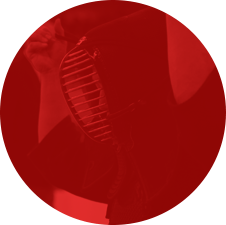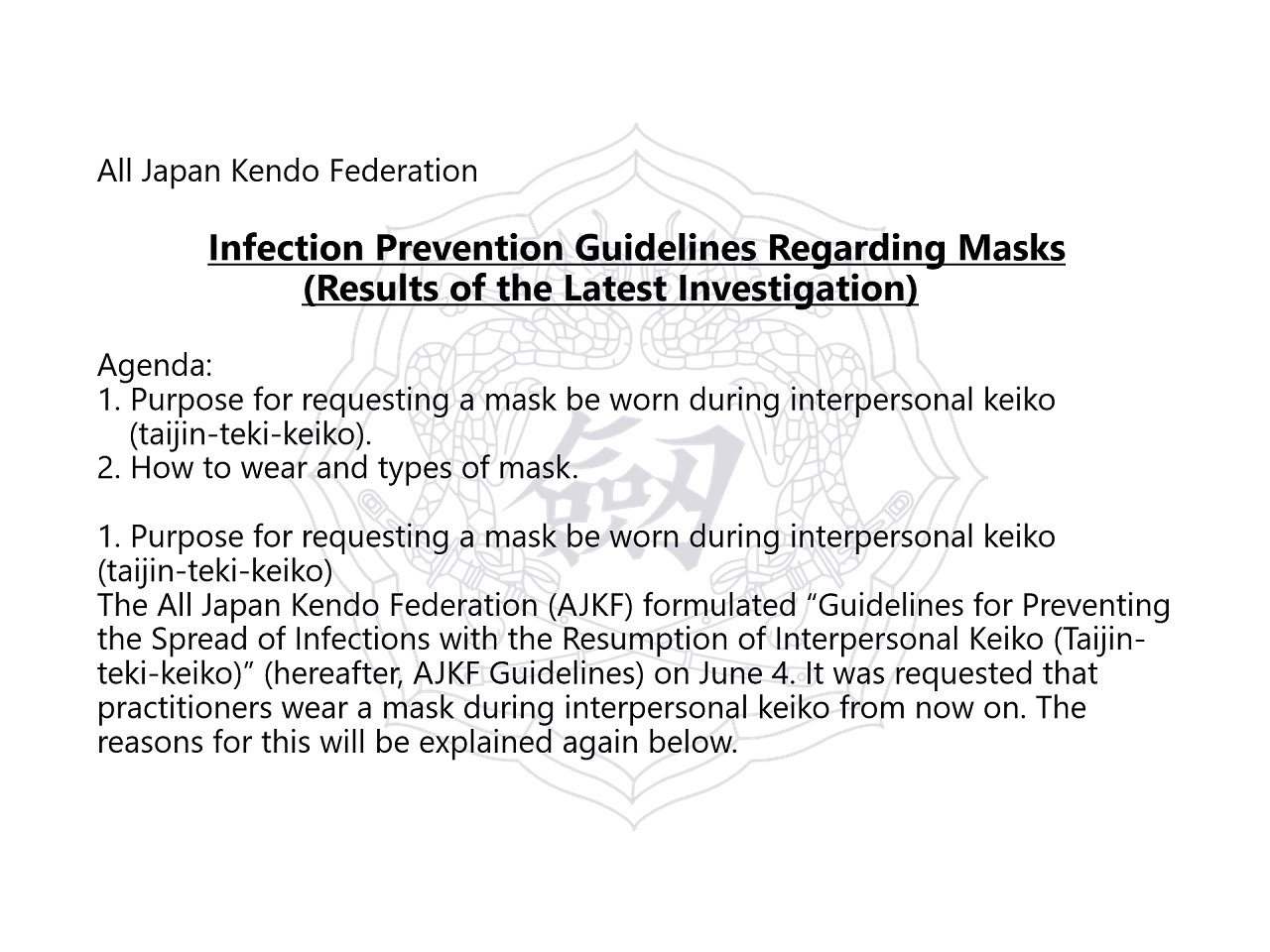
AJKF News
updated
Infection Prevention Guidelines Regarding Masks (Results of the Latest Investigation)

1. Purpose for requesting a mask be worn during interpersonal keiko (taijin-teki-keiko)
The All Japan Kendo Federation (AJKF) formulated “Guidelines for Preventing the Spread of Infections with the Resumption of Interpersonal Keiko (Taijin-teki-keiko)” (hereafter, AJKF Guidelines) on June 4. It was requested that practitioners wear a mask during interpersonal keiko from now on. The reasons for this will be explained again below.
The main routes of infection with COVID-19 infections are through the spraying of droplets and direct contact. As such, it is especially important that spray from the mouth is blocked. With our “new way of life”, the government is alerting people to not get too close to others, to avoid partaking in face-to-face meals, and to refrain from speaking loudly to prevent infections occurring from spray coming from the mouth. Kendo always uses vocalization (hassei), which results in droplets coming from the mouth, thereby increasing the risk of infection. In fact, a cluster of infections already occurred through kendo keiko. To resume interpersonal keiko, it was deemed crucial to somehow prevent droplet spray through vocalization.
Masks can be considered effective equipment for preventing droplet spray. In addition, many kendo-gu shops have developed plastic shields, such as mouthguards. The AJKF conducted experiments at Shin Nippon Air Technologies Co., Ltd. to ascertain how effective shields are for blocking spray. This particular company is very experienced in conducting this kind of experiment.
Results showed that, when compared to wearing only a men, masks reduced the amount of spray by around 90%. Using a shield reduced droplet spray by around 70%. Therefore, the AJKF determined that wearing a mask should be a mandatory measure for the resumption of training, and that using a plastic shield only cannot be recommended. However, it is possible to block droplets by almost 95% when masks are used in combination with shields. As the shield is effective for preventing spray coming from training partners, the AJKF recommends that a mask and shield be used in combination. It is believed that COVID-19 is particularly hazardous for elderly kendo practitioners, so the AJKF urges that that they wear both a mask and a shield. In addition, small droplets of spray can remain floating in the air, so be sure to use fans and the like to properly ventilate the dojo.
The AJKF’s main purpose for recommending these measures is to mitigate outgoing and incoming spray generated in training, and ultimately prevent infection. Still, it is absolutely vital that attention be paid to respiratory problems and heatstroke that can easily be caused by wearing masks. For this reason, as measures against heat stroke the AJKF Guidelines urge that training durations be shortened, frequent hydration breaks are introduced, and the temperature of training venues be monitored and controlled.
2. Regarding masks
The AJKF Guidelines state that masks are necessary. Hereafter, any mask worn inside the men will now be referred to as a “Men-mask”. For the Men-mask to not restrict breathing, suitable material must be used, and the design must allow air to escape down and to the sides. An example made from a tenugui was shown.
Nevertheless, there have been questions and opinions proffered by people in the kendo community regarding breathing difficulties caused by wearing Men-masks. In response to these questions, the AJKF published the “Supplemental Explanations for the Guidelines” (June 8, 2020), and also conducted additional investigations into mask types and how they are worn. The results of this new round of experiments are summarized below.
How to wear a mask
- As pointed out in the supplemental explanation, breathing difficulties are alleviated when wearing a Men-mask if a small space is made between the mask and the mouth. (It looks three-dimensional when viewed from the side.)
- As a result of the latest investigation, it was found that when wearing a Men-mask, there was not much difference in the suppression of droplet spray even if the nose was uncovered. Therefore, to relieve breathing problems, it is possible to wear a Men-mask with the nose uncovered.
- Even if only a small piece of fabric was suspended in front of the mouth, it effectively blocked spray if it touched the mouth directly.
Types of mask
In addition to masks made from tenugui, other types such as paper masks, urethane masks, polyester masks, masks made from swimming costume material, running masks, and jogging masks were also tested. These tended to block spray more effectively than a Men-mask made from a tenugui.
- Therefore, we have concluded that there is no need to limit the Men-mask to that made from a tenugui.
- Here, a mask refers to something that covers and touches the mouth directly. Something that is attached to the inside of the men is NOT a Men-mask. Please note that such designs tend to be less effective in blocking spray than those that cover the mouth.
Following the guidance above, all practitioners should choose a Men-mask that they find comfortable. Also, we recommend that there is some space between the Men-mask material and the mouth, that the nose is uncovered, or that the mask is suspended in front of the mouth (as long as it maintains a degree of contact) to alleviate breathing difficulties. Furthermore, do not forget measures to prevent heatstroke.
We understand that a manufacturer is currently in the process of creating a new material which, together with a very high degree of droplet suppression, has low pressure loss value (used to measure breathability). This means that breathing through the material will be easier. Some martial arts equipment manufacturers are planning to start selling new equipment for this purpose. The AJKF is looking forward to the development of these new products and will conduct further investigations as necessary to facilitate safe kendo practices.
Infection Prevention Guidelines Regarding Masks (Results of the Latest Investigation)

